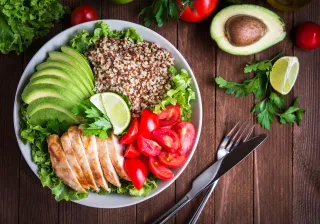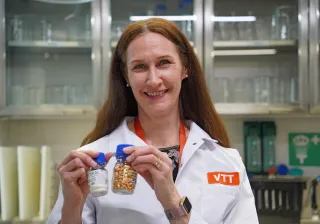How and why is biotechnology revolutionizing food production? Jussi Manninen and Emilia Nordlund from VTT and Pasi Vainikka from Solar Foods had a discussion on cellular agriculture in a VTT Sip of Science panel in September.
Antti Vasara, VTT President and CEO, recently named biotechnological food production as one area of exponential hope. This refers to a sector which, through reforms, can solve some of the most significant problems in the world while, at the same time, create a growing high-skill-level industry.
Global population growth and challenges in food production put the sector under pressure for renewal. Food production accounts for up to 25% of greenhouse gas emissions and 75% of clean water consumption. The use of pesticides is an important factor behind the mass extinction of species. About half of the arable land is already used by agriculture, and agriculture cannot be expanded without limit.
Biotechnology and cellular agriculture offer methods for sustainable food production. Cellular agriculture uses microbes and bioreactors instead of fields and farmed animals. Microbes transform glucose and lignocellulose, for example, into a microbiological mass suitable as a raw material or a component of food. That’s how, for example, meat substitutes or proteins and lipids of animal origin can be produced.
Wins over traditional production in many respects
Cellular agriculture is more ethical and ecological than traditional food production. For example, egg white protein production by cellular agriculture produces about 75% less greenhouse gas emissions when compared to chicken farming. Cellular agriculture uses also about 90% less land than a chicken farm, says Emilia Nordlund.
Also cellular agriculture needs water and energy. The energy source of the Solar Foods process is based on hydrogen and not on sugar or other agricultural products. The process produces biomass which, in turn, produces powder similar to soya protein. The environmental impact of the product is about 1-10% of the impacts of traditional plant or animal proteins, says Pasi Vainikka.
The benefits of cell agriculture also include safety: no harmful substances can enter a closed system through soil. There is no need for antibiotics in production either.
Will protein supplant the breakfast egg?
Cellular agriculture products can be used as raw materials for the food industry, and also as animal feed. In the feed market the margins are weaker. Solar Foods aims to make its products raw material for human food. This requires that functionality and nutritional values are as they should be.
Taste also matters. While cellular agriculture products can replace traditional food products, they will unlikely do it entirely. With regard to everyday foods, new alternative products may have less trouble gaining foothold. However, Camembert cheese, to take an example, will continue to be relished on special occasions in the future according to Vainikka.
Production of crops in the fields will still be important part of agriculture and an origin for our food raw materials.
Egg protein is one of the key materials in food production, and, therefore, its replacement by means of cellular agriculture is interesting. Protein produced with methods based on cellular agriculture should function like traditional eggs. "Egg protein will hardly replace eggs at breakfast. However, in bakery products it would work well,” says Nordlund.
Towards a new industry
The development of cellular agriculture is now moving towards the emergence of a new industrial sector. This is a revolutionary change: not only more efficient meat production but also entirely new technologies and platforms. Solar Foods has started pilot production of its product and will scale it up to hundredfold in the next 30 months. After that the construction of a factory will start, says Vainikka.
The capital market has also registered the developments in the sector. Investors now see the same potential in food production as in the development of the IT sector, social media or e-commerce in previous years. This will drive innovation and the development of the sector forward.
Consumers also play an important role - large companies make decisions based on growth figures. “The timing for food production disruption is good for consumers. Consumers are ready to adopt new products such as meat and milk substitutes. It also appears that they can be produced at a competitive price,” says Nordlund.
Scalability and legislation are the key factors
The change in food production is just beginning and requires the scaling up of cellular agriculture production. The second key issue relates to legislation: It can be used either to limit or accelerate the change. So far, EU legislation has adapted slowly, and therefore, the USA and Asia have a stronger position.
Finland represents the forefront of food innovation in Europe. Its market offers a good test environment for new products, as the Finns are open to them. Finland also has a good science-based cluster, a great deal of competence for developing the field, an agile innovation system and a way of cooperation based on a flat hierarchy. These are good starting points to be the pioneer and impactful actor in the growing business field.
While the future of cellular agriculture is still open, the panellists see it as bright. Unnecessary production stages will be eliminated. “My grandchildren may find it strange that we used to raise a whole animal with hair and ears while we only wanted meat,” summarizes Vainikka.
"In any case, I believe and I hope that in the future we will enjoy food as much as we do today," says Nordlund in conclusion.






